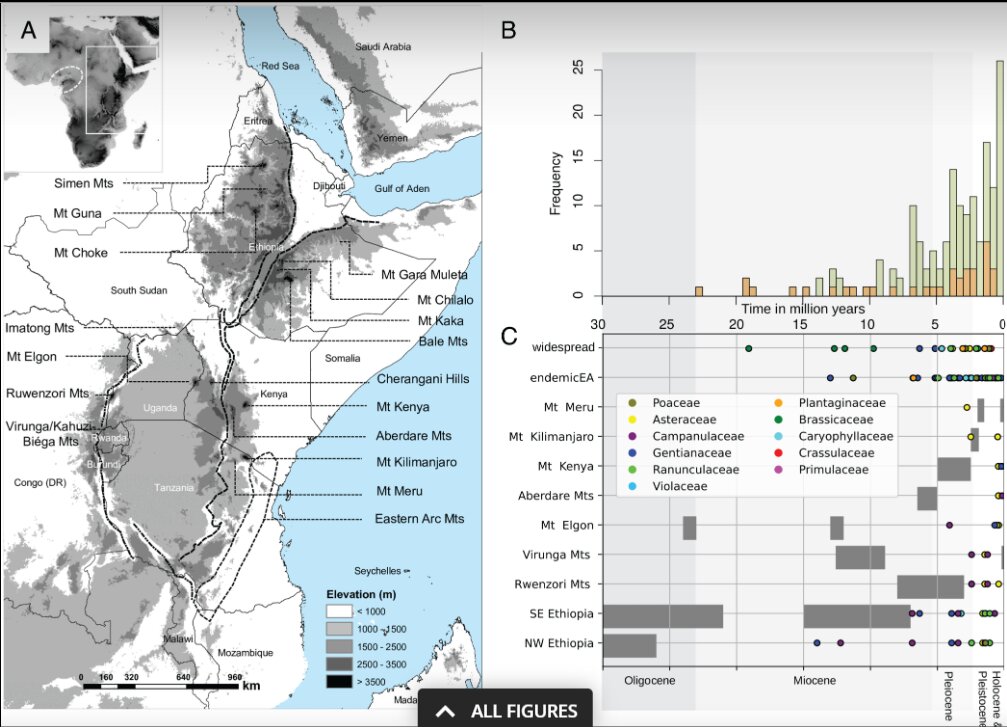
![Geographic distribution and recruitment to the afroalpine flora (>3,500 m). (A) Major mountains and mountain regions in eastern Africa. The Great Rift Valley is shown as stippled lines. (B) Numbers of afroalpine colonization (orange) and in situ diversification (olive) events per 0.5-Ma time bin. Colonizations, here represented by stem nodes, must be interpreted as maximum age estimates for events that are more recent to an unknown degree. (C) Stem age estimates of afroalpine species in relation to mountain orogeny [gray bars; Gehrke et al. (9)]. Species are colored according to family. Local endemics (species restricted to one or two mountains) are mapped to individual mountains; the remaining species are classified as “eastern African endemics” (endemicEA) or as “widespread.” Age estimates in B and C represents both Bayesian median node ages of individual seed plant clades. Credit: <i>PNAS</i> pnas.org/doi/10.1073/pnas.2112737119#fig01 The enigmatic tropical alpine flora on the African sky islands is young, disturbed, and unsaturated](https://skynews.icu/wp-content/uploads/2022/05/The-enigmatic-tropical-alpine-flora-on-the-African-sky-islands.jpg)
New insights into the evolutionary origins of unique African high mountain botanical diversity is published in PNAS.
On the tops of the high mountains in the tropics of Africa grow unique communities of highly adapted, often bizarre looking plants. Giant rosette forming senecios and lobelias tower above dwarf shrubs and other plants that have found strategies to resist extreme daily fluctuations between wintery, often sub-zero temperatures at night, followed by high insolation, summer-like conditions during the day—all year round. These “sky islands” poke out of a sea of very different lowland tropical vegetation. They are isolated and unique.
Martha Kandziora, a recent MSCA Widening Fellow at CUNI, is the lead author of a new paper, published in the journal Proceedings of the National Academy of Sciences. She and colleagues analyzed genome data from an unprecedented sampling across afroalpine plants using novel techniques developed by Kandziora. They revealed a dynamic evolutionary history of this remarkable flora, with frequent colonizations from distant temperate zones at higher latitudes followed by extinctions, most likely caused by climate changes during the ice age cycles.
Extinction and recolonization of the afroalpine flora may have been frequent as measured on an evolutionary timescale—in this case, mostly within the last 5 to 10 million years—but this is nothing compared to the rapid pace of modern human-mediated extinctions. Today, whole ecosystems are affected by human-induced climate change. On top of habitat destruction (particularly through over-grazing), the afroalpine flora will be particularly vulnerable to human-induced climate warming as it reduces the alpine habitat into successively smaller areas at higher elevations.
The work is the latest in a series of papers presented by Kandziora and international collaborators shedding light on the origins of plant groups found in tropical alpine zones—not only of Africa, but also of the much greater extent of Páramo in the high Andes of South America. Ongoing research using cutting edge genomic data and bioinformatic tools will search for general processes underlying plant diversifications in these fascinating habitats.
How alpine grasslands respond to climate change and anthropogenic impacts
Martha Kandziora et al, The enigmatic tropical alpine flora on the African sky islands is young, disturbed, and unsaturated, Proceedings of the National Academy of Sciences (2022). DOI: 10.1073/pnas.2112737119
Charles University
Citation:
The enigmatic tropical alpine flora on the African sky islands is young, disturbed, and unsaturated (2022, May 30)
retrieved 30 May 2022
from https://phys.org/news/2022-05-enigmatic-tropical-alpine-flora-african.html
This document is subject to copyright. Apart from any fair dealing for the purpose of private study or research, no
part may be reproduced without the written permission. The content is provided for information purposes only.